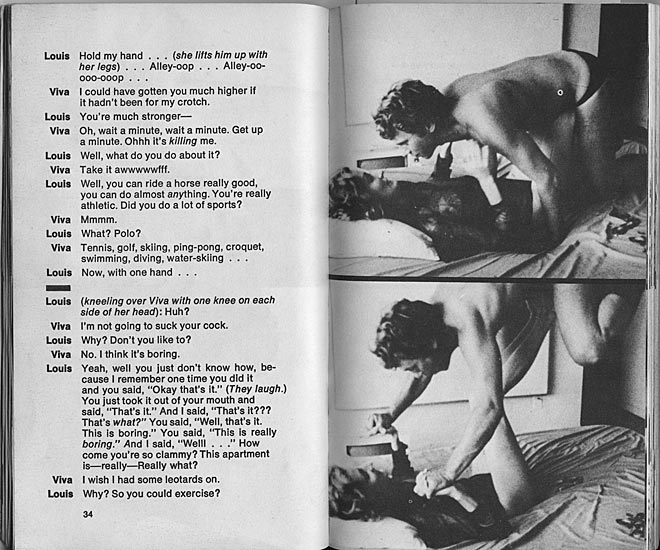WARHOLSTARS 1928 - 1959
1928 - 1959 - 1960 -1962 - 1963 - Jan - May 1964 - June-December 1964 - 1965 - 1966 - 1967 - 1968 -1969 - 1970 - 1974 - 1975 - 1979 - 1980s+
AUGUST 6, 1928: ANDY WARHOL IS BORN.
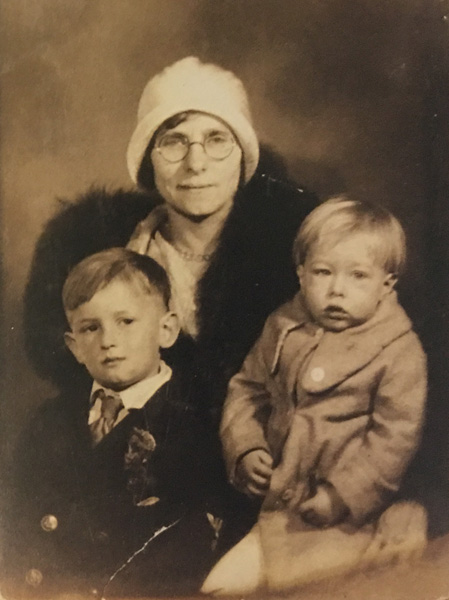
Julia Warhola with John Warhola (left) and Andrew Warhola (right) (1931)
Andy Warhol was born in Pittsburgh, Pennsylvania. His birth name was Andrew Warhola (or 'Varchola'). His parents, Ondrej (aka Andrej) Warhola and Julia (née Zavacky) were immigrants from Miková in northeastern Slovakia. (BC11)
Warhol gave various dates for his birth but the correct one is August 6, 1928, based on a Certificate of Baptism.
For variations on Andy Warhol's birthdate, see: "Andy Warhol: From Nowhere to Up There."
Warhol had two older brothers - Paul Warhola, born in 1922 and John Warhola, born in 1925. (SC3) John died in 2010 and Paul in 2014. (Two years previously, Paul had issued a statement denying the authenticity of a painting of Rudy Vallée that had made the news as an early Warhol, purchased at a garage sale in Las Vegas by Andy Fields.)
According to an essay by Warhol's college classmate, Bennard B. Perlman, published in the inaugural publication of The Andy Warhol Museum in 1994, Andy Warhol was born at 73 Orr Street. (AWMU147) This was also the address published in Andy Warhol 365 Takes by the staff of The Warhol museum in 2004 which noted that Warhol "was born in a shack like row house at 73 Orr Street in Pittsburgh." (AWM4) A recent biography of the artist, however, Pop: The Genius of Andy Warhol
published in 2009, claims that "When Andy was born, the family was living in a two-room slum apartment on Beelen Street, overlooking the Ohio River." (SC4) Paul Warhola recalled that the Beelen Street home was the third address that the family lived in. (See "Andy Warhol: from Nowhere to Up There," p. 4)
Was Andy Warhol Dyslexic?
Wayne Koestenbaum claimed that Warhol was dyslexic in his 2003 biography of the artist. However, there is no medical evidence to support this. When Warhol graduated from high school in 1945 (at the age of sixteen), he ranked 51 in a class of 278 (DB18), which would be quite a high ranking for somebody with dyslexia in the 1940s, even given the academic help Warhol sometimes received from other students.
The dyslexia claim was repeated in Pop: The Genius of Andy Warhol in 2009. The "telltale" spelling errors made by the artist, as first presented by Koestenbaum and then repeated by the authors of Pop: The Genius of Andy Warhol, probably have more to do with the fact that Warhol was raised by parents who spoke a foreign language at home rather than with anything having to do with dyslexia.
1928 OR 1929: ANDY WARHOL'S FATHER HAS HIS GALLBLADDER REMOVED.
From Pop: The Genius of Andy Warhol
:
"In 1928 or 1929, Ondrej Warhola had his gallbladder removed. Paul [Warhola] felt that the operation wasn't entirely successful. 'Dad just never recouped his strength, his ailments lingered.' At some point in the late thirties, while he was working a construction job in West Virginia, Ondrej drank tainted water and contracted jaundice. 'The other guys got sick, but they recovered,' said Paul. 'Dad's resistance was so low that he never got better. He died of TB peritonitis' in May 1942." (SC8)
1934
DECEMBER 16, 1934: LOUIS WALDON IS BORN IN MODESTO, CALIFORNIA. (IMDB)
Louis Waldon and Viva Hoffmann in Andy Warhol's Blue Movie which was released as a book after the film was banned - see "Blue Movie" (1968)
1936
APRIL 9, 1936: VALERIE JEAN SOLANAS IS BORN.
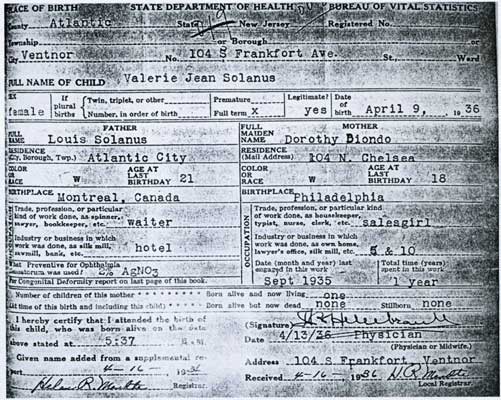
Valerie Solanas' birth certificate - see "Valerie Solanas," p. 1
Valerie was born in Ventnor, New Jersey. She later became famous as the person who shot Andy Warhol.
AUTUMN 1936: ANDY WARHOL GETS ILL.
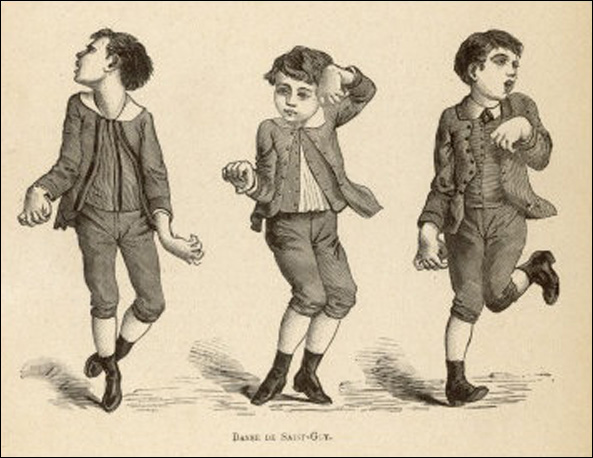
Vintage French illustration of boys afflicted with St. Vitus' Dance (Chorea) known as Danse de Saint-Guy in France
At the age of eight ANDY WARHOL came down with a rare disease called chorea, or St. Vitus' dance, "an illness of the nervous system that under certain circumstances can prove fatal." According to Paul Alexander in Death and Disaster: The Rise of the Warhol Empire and the Race for Andy's Millions, Warhol had originally come down with rheumatic fever. At the time, before antibiotics, approximately 10 percent of cases of rheumatic fever worsened and became chorea (also called St. Vitus' Dance). Warhol stayed in bed for about ten weeks. When he finally returned to school he had a relapse of the illness on the first day and returned to bed. (DD22-3)
Andy Warhol's brother, Paul, also recalled that Andy had Scarlet Fever. See: "Andy Warhol: From Nowhere to Up There, p. 4" (bottom of page)
Although Warhol's skin problems have sometimes been attributed to the illness, his brothers Paul and John recalled that the skin problems that affected Warhol's face started later, at the onset of adolescence. (SC6)
Denton Cox, Warhol's doctor at the time of the artist's death, would also later comment on skin problems that Warhol had which affected his scrotum:
From Pop: The Genius of Andy Warhol
:
"Of the physical problems that played such a large role in shaping Warhol's personality, one - whose impact may have been greater than any other - has never been publicly discussed. Evidently present since birth, the condition affected the appearance of Warhol's genitalia. 'He had very prominent hemangiomas, or collections of blood vessels, chiefly on the scrotum,' according to Denton Cox, Warhol's doctor for almost three decades. 'They looked like little collections of rubies, lots of them.' To Warhol, it was nothing less than a disfigurement, and he was ashamed, extremely self-conscious. 'It put him into a disadvantageous emotional place in every relationship.' As a result, he was 'only comfortable when things were casual, and where he could be self-protective; where he could mostly watch, or participate in a way that didn't expose him.'" (SC8)
1937
JUNE 16, 1937: ONDINE IS BORN BOB OLIVO. (FM)
Ondine, a regular at Andy Warhol's Factory, was an amphetamine addict known for his acerbic wit. His Warhol films included Loves of Ondine (with Joe Dallesandro and Viva) and The Chelsea Girls.
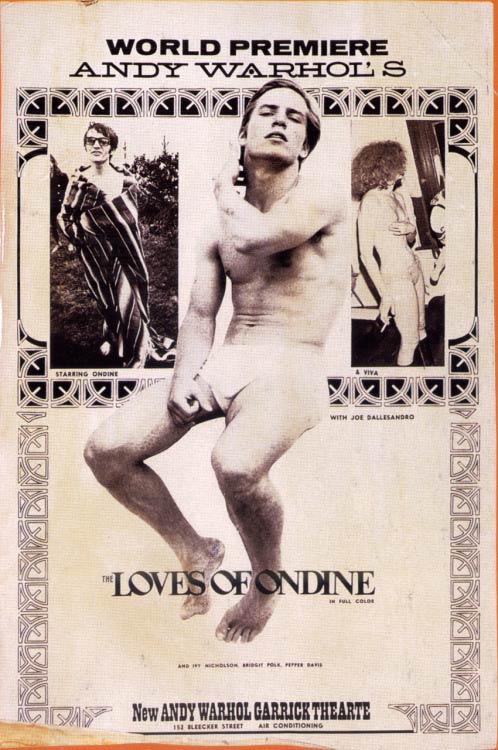
Loves of Ondine poster - starring Joe Dallesandro, Ondine and Viva
c. 1937: ANDY WARHOL GETS A CAMERA.
He develops the film in his own makeshift darkroom in the basement of his house. (AWM5)
1938
AUGUST 23, 1938: VIVA IS BORN.
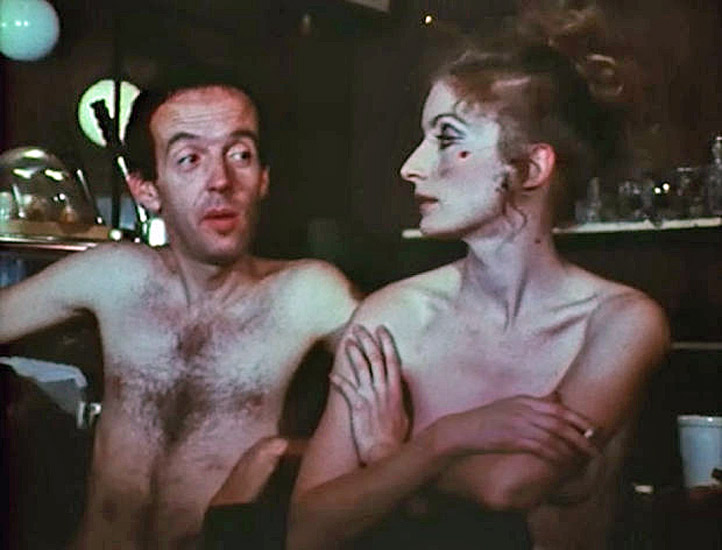
Taylor Mead and Viva in Andy Warhol's film, The Nude Restaurant, which also featured "Julian Burroughs" - a draft dodger in real-life whose name was actually Andrew Dungan
to "Interview with Andrew Dungan (aka Julian Burroughs)"
Viva was born in Thousand Islands, New York and raised in Syracuse. Her birth name was Janet Susan Mary Hoffmann. She was the eldest of nine children born to conservative parents. Her father was a prominent criminal lawyer. After attending parochial grade schools, she went to Marymount, a Catholic College in Tarrytown, New York. She studied in Paris at the Sorbonne in her junior year, living in a convent on the Right Bank while studying art. (FM/DB260)
OCTOBER 16, 1938: NICO IS BORN.
Nico started out as a model and actress and ended up as the heroin-addicted leader singer in the Velvet Underground before she left and persued a solo career.
A heroin addicted Nico on tour in the U.K. from the 1980s from the documentary Nico Icon
Nico was born in Cologne and raised by her mother and grandfather in Spreewald - a small town on the outskirts of Berlin. Her birth name was Christa Paffgen.
Nico was educated first in France, then in Italy and spoke seven languages. She also went to a private school in Germany, worked as a child model, and later studied acting and singing at the Lee Strasberg Method Studios. During the air raids in the second world war, she took shelter in the family's bath tub and always remembered the sound of the bombs. (UT32-33)
According to Victor Bockris and Gerard Malanga in Up-tight,The Velvet Underground Story, "At 15 while vacationing at a friend's villa in Rome, Nico was introduced to some young actors from Cinecitta (Italy's Hollywood), who invited her to the set of a movie they were making with an eccentric director named Frederico Fellini." She ended up appearing in the movie they were making - La Dolce Vita. (UT32-33)
Bockris/Malanga's version of events conflights slightly with other accounts. According to David Bourdon in Warhol, Nico was born in Cologne, grew up in Berlin, worked as a model in Paris and Rome and was seventeen years old when she appeared in La Dolce Vita. (DB221) A site user has, however, pointed out that Nico was actually 20 years of age when she appeared in Fellini's film. According to Wikipedia, she was born 16 October 1938 and La Dolce Vita was filmed from 16 March to 15 August 1959.
1939
SEPTEMBER 6, 1939: BRIGID BERLIN IS BORN.
Brigid's father, Richard E. Berlin, was chairman of the Hearst Corporation. Her mother, Honey Berlin married him when she was 21 years. Nine months after their marriage, Brigid was born. Brigid had two sisters - Richie and Christina and a brother, Richard. Brigid's mother put her on "speed" when she was a child to make her lose weight. (PS)
Socialite turned troublemaker, Brigid would later be flimed shooting up amphetamine in Andy Warhol's movie The Chelsea Girls. (See filmography for a list of her films.) She remained Warhol's colleague and phone-mate throughout his life (one of the "B's" in The Philosophy of Andy Warhol (From A to B and Back Again) and also appeared in video projects produced by Andy Warhol and Vincent Fremont, such as Fight, with Charles Rydell. (See "Jerome Hill and Charles Rydell," p. 3)
Brigid was an artist in her own right. Her needlepoint cushions featuring tabloid press headlines are notorious. In 2015, Dagon James and Anastasia Rygle brought out a book of her Polaroids. Her "Cockbook" was purchased by the artist Richard Prince in the about 2008.
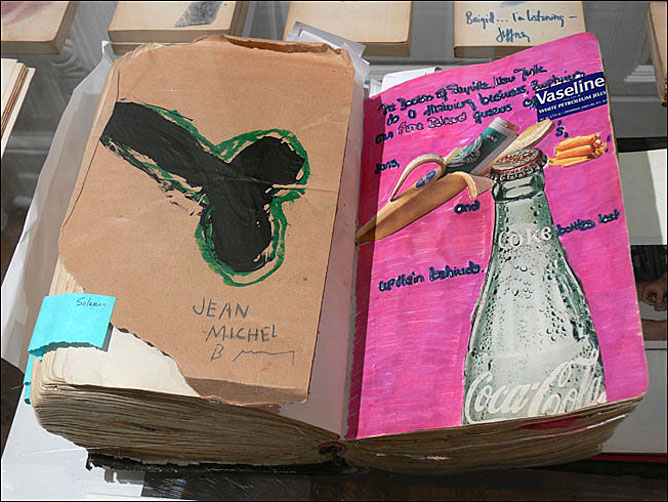
Brigid Berlin's Cock Book
1940
OCTOBER 23, 1940: BABY JANE HOLZER IS BORN. (imdb)
At "it" girl before there were "it" girls, Jane Holzer was born in Palm Beach, Florida. Her birth name was Jane Brookenfeld. Her father, Carl Brookenfeld, made his fortune in real estate. She later married Leonard Holzer who had also made a fortune through real estate. Her Warhol films included Soap Opera. She left the Factory because of the druggy atmosphere and went on to start a short-lived ice cream chain, before becoming a Hollywood movie producer and successful real estate investor like her father.
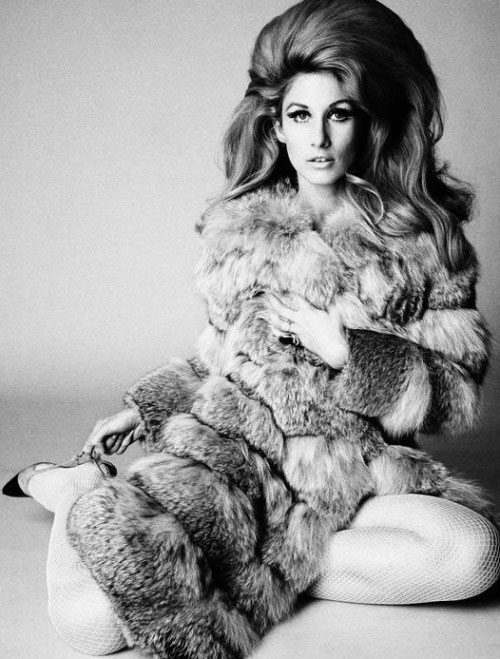
Baby Jane Holzer in a Mary Quant coat (Photo: David Bailey)
FEBRUARY 22, 1940: BILLY NAME IS BORN.
Billy Name was born Billy Linich at Vassar Hospital in Poughkeepsie, New York. According to Billy, he grew up as an "average repressed young American" until 1958 when he transplanted himself to the Village in New York and "magically" became an occult artist. (B) (R.I.P. my friend.)
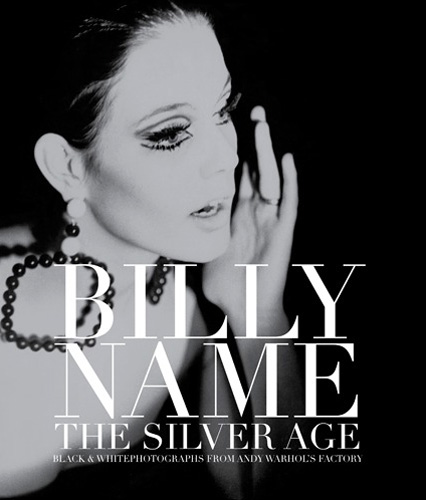
Cover of Billy Name's book of Factory photographs published by Reel Art Press
DECEMBER 5, 1940: JOHN CALE IS BORN.
Cale was born in Crynant, South Wales. He attended school in Crynant until he was seventeen years old and then studied classical music at Goldsmith College in London from 1960-63. In 1963 Cale was awarded a scholarship to study at Tanglewood in the States and then moved to New York to start a band called The Dream Syndicate with LaMonte Young. (UT12-13)
1942
MARCH 2, 1942: LOU REED IS BORN.
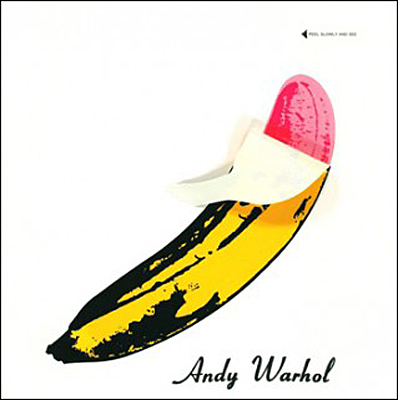
The original "peel slowly and see" album cover for The Velvet Underground and Nico - produced by Andy Warhol
Lou Reed was born Lewis Alan Reed at Beth El Hospital in Brooklyn, New York to an accountant and an ex-beauty queen housewife. Reed's family moved to 35 Oakfield Avenue, Freeport, Long Island in 1953, where he spent his childhood. (LR16-7) He realized he had homosexual urges at the age of thirteen. At the age of fifteen he formed a band called The Shades and put out a single on the Time label called So Blue. (LR22-3/UT15)
1942: ANDY WARHOL GRADUATES FROM HOLMES SCHOOL.
After graduating from Holmes, he went to Schenley High School, studying art under Joseph Fitzpatrick who also taught classes at the Carnegie Institute. (AWM6)
AUGUST 29, 1942: STERLING MORRISON IS BORN.
Sterling was born in East Meadow, Long Island. His birth name was Holmes Sterling Morrison, Jr. He was raised by middle-class parents and had two younger brothers, Robert and William and three younger sisters, Dorothy, Kathleen and Marjorie. He studied the trumpet from age 7 to 12 and then, inspired by Bo Diddley and Chuck Berry, switched to guitar when his trumpet teacher was drafted. He later met Lou Reed while attending Syracuse University. His roommate at Syracuse was Maureen Tucker's brother, Jim. Their room was beneath Lou Reed's room. (UT19)
MAY 1942: ANDY WARHOL'S FATHER DIES. (SC8)
Warhol's father, ANDREJ (aka Ondrej) WARHOLA, died from a jaundiced liver. According to Paul Alexander in Death and Disaster, The Rise of the Warhol Empire and the Race for Andy's Millions, "some friends questioned why the liver was diseased in the first place. Many suggested that it was a direct result of his gallbladder being removed some years before. Others would imply that perhaps Ondrej [Warhol's father] drank excessively, the prolonged effect of which damaged his liver. Either way, it was obvious that Ondrej's gallbladder was susceptible to disease, a hereditary trait he passed on to Andy." (DD23)
From Pop: The Genius of Andy Warhol
:
"In 1928 or 1929, Ondrej Warhola had his gallbladder removed. Paul [Warhola] felt that the operation wasn't entirely successful. 'Dad just never recouped his strength, his ailments lingered.' At some point in the late thirties, while he was working a construction job in West Virginia, Ondrej drank tainted water and contracted jaundice. 'The other guys got sick, but they recovered,' said Paul. 'Dad's resistance was so low that he never got better. He died of TB peritonitis' in May 1942." (SC8)
Warhol was fourteen years old at the time and did not attend his father's funeral. According to his brother, PAUL WARHOLA, their mother was afraid that the funeral might lead to a recurrence of Andy's "nervous condition". Young Warhol hid under a bed upstairs during the wake and refused to come down to see his father laid out in in the open casket in the living room. (BC18)
1943
MARCH 20, 1943: GERARD MALANGA IS BORN.
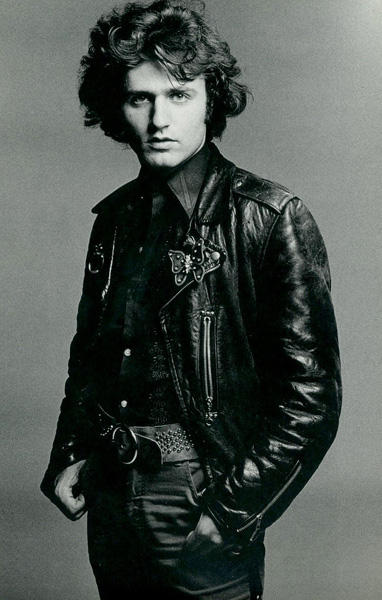
Gerard Malanga (1969) (Photo: Francesco Scavullo)
APRIL 20, 1943: EDIE SEDGWICK IS BORN.
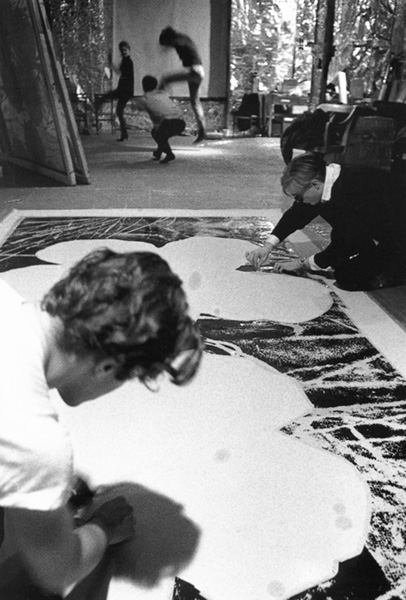
Edie Sedgwick dancing with Chuck Wein and Larry Latreille in the back of the Factory as Gerard Malanga and Andy Warhol work on a Flowers painting, 1965. (Photo: David McCabe)
Edie Sedgwick was born at the Cottage Hospital in Santa Barbara, California. In the sixties, she told ULTRA VIOLET that as a child both her father and brother tried to sleep with her, but she rejected their advances. When she discovered her father making love to another woman, she tried to tell her mother. Her father told her she was insane and called the doctor. Edie told Ultra, “They gave me so many tranquillizers I lost all my feelings.”
Edie suffered from anorexia in school, which continued into her adult life. Later when she moved to New York, she demonstrated vomiting to Ultra Violet by tickling her uvula with a scarlet ibis feather while listening to a Hoagy Carmichael record. She also liked Ornette Coleman. (UV206-7)
JUNE 23, 1943: ERIC EMERSON IS BORN.
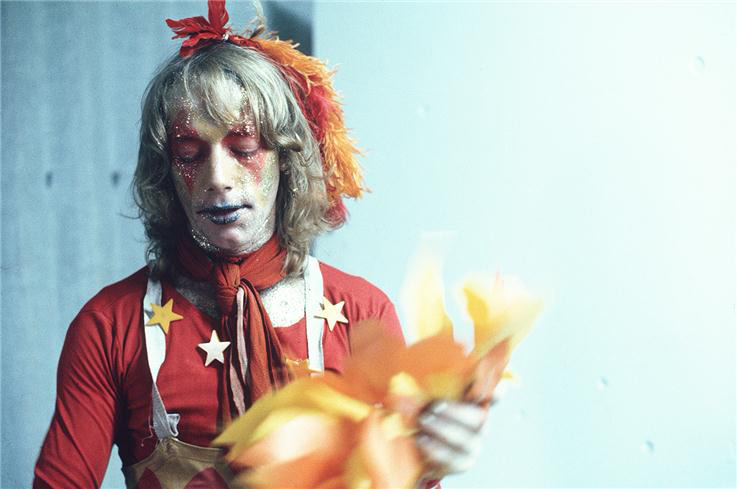
Eric Emerson, 1973 (Photo: ©Chris Stein) (Morrison Hotel Gallery)
See: "Wonderboy: The Life, loves and death of Eric Emerson."
DECEMBER 8, 1943: MARY WORONOV IS BORN. (MW11/IMDb)
Mary Woronov was born in Brooklyn, New York and studied art at Cornell University. Her step-father was a cancer surgeon. About her father, Mary would later say "women loved him... most of the emergencies at the hospital were blondes or brunettes." (MW14)
Mary wasn't allowed to smoke pot at home, but she was permitted to take as many of her mother’s "speed" (amphetamine) pills as she wanted. (MW12)
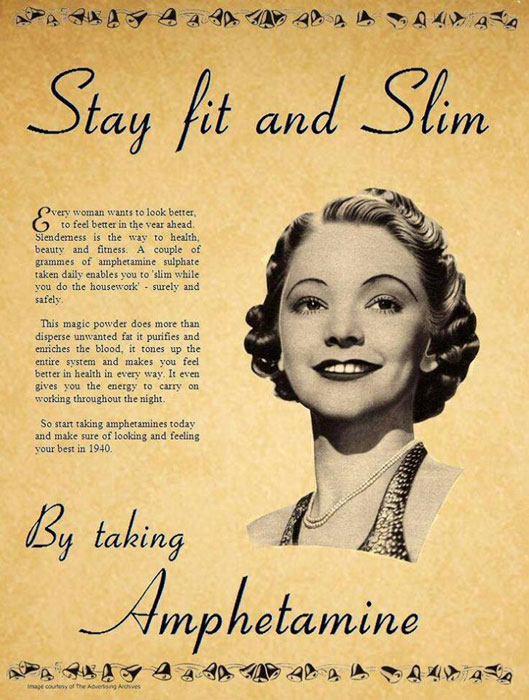
Advertisement for Amphetamine, 1940
Mary Woronov:
"When Mom didn't clean the house fast enough, Daddy put her on speed after diagnosing an underactive thyroid... at three in the morning I'd find her curled under the yellow glow of a lamp in a darkened living room... reading The Rise and Fall of the Third Reich...
'Mom, why don't you go to bed? It's late.'
'Uh huh, I will... in a minute.'
'Mom, you read that book last year year, don't you remember?' " (MW13)
1944
NOVEMBER 24, 1944: CANDY DARLING IS BORN. (FM/CD10)
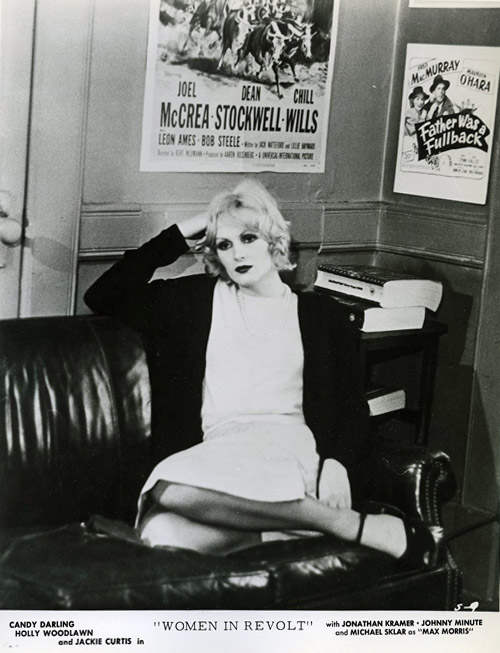
Publicity still for Women in Revolt
Candy Darling was born in New York. Her birth name was James Lawrence Slattery. Various birth dates appear in Warhol literature for Candy, but November 24 is the generally accepted date - although Bob Colacello thought s/he was born in 1946. (BC79)
Candy Darling, Holly Woodlawn and Jackie Curtis are often referred to as Warhol "superstars" but their films, Flesh (with Jackie Curtis and Candy Darling), Trash (with Holly Woodlawn) and Women in Revolt (with Candy, Holly and Jackie) were directed by Warhol's cohort, Paul Morrissey. Andy Warhol's name appeared on publicity and later on the packaging of videos, but that was for sales purposes. Andy Warhol is credited as producer or co-producer on the films, but that effectively means he paid for the costs of production. Some people in the films directed by Paul Morrissey have claimed to be Warhol "superstars" as a result of being in the Morrissey films - such as the cabaret entertainer, Penny Arcade, but she was never in a film directed by Andy Warhol.
1945
1945: ANDY WARHOL GRADUATES FROM HIGH SCHOOL.

Schenley High School Yearbook
Although some accounts of Warhol's life portray him as a loner or outcast in high school, he was listed as his Home Room secretary in the Schenley High School yearbook and described as being "As genuine as a finger print."
After graduating from Schenley High School, he studied painting and design at the Carnegie Institute of Technology. (DD24) Warhol originally intended to study art education at the University of Pittsburgh in order to become an art teacher, but he changed his mind and applied to the Carnegie Institute to study pictorial design with the intention of becoming a commercial illustrator. (AWM6)
1945: MAUREEN ('Mo') TUCKER IS BORN.
Mo was born in New Jersey. She later became the drummer for The Velvet Underground despite the fact that "John [Cale] was adamant about not wanting any girls in the band." (Mo/UT29)
1946
OCTOBER 26, 1946: HOLLY WOODLAWN IS BORN. (HW29/IMDb/BC81)
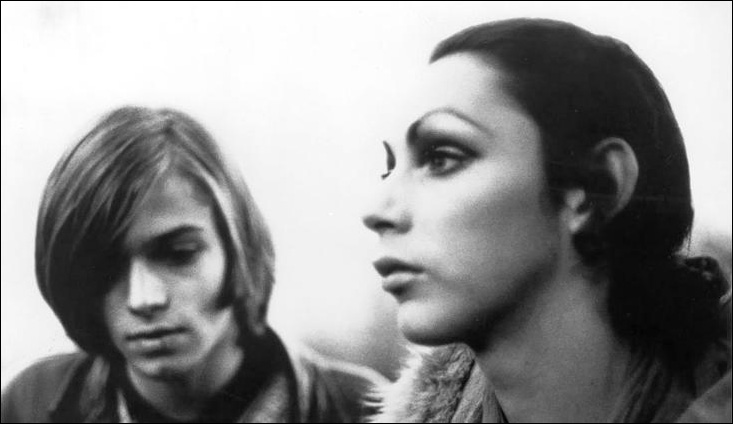
Holly Woodlawn (R) with real-life boyfriend, Johnny Putnam during the filming of Trash
Holly Woodlawn was born Harold Santiago Rodriguez Franceschi Danhackl in Juana Diaz, Puerto Rico. Holly's mother was Puerto Rican, her father an American soldier of German descent who met Holly’s mother on leave, got her pregnant, married her, then quickly departed.
Holly was raised in a household that included “8 aunts, 1 uncle, 5 cousins, 2 grandparents, 6 chickens and 3 pigs.” (HW28-9) She later changed her first name to Holly after Holly Golightly in Truman Capote’s story Breakfast at Tiffany's. (HW3)
Holly was not part of the original silver Factory. She started making films under the Warhol banner after Warhol had moved his offices to 33 Union Square West. Although Holly Woodlawn's films were directed by Paul Morrissey, they were "produced" by Andy Warhol and his name usually appeared before the title of the films in advertising - see Trash.
1947
FEBRUARY 19, 1947: JACKIE CURTIS IS BORN. (J)
Jackie Curtis was born John Holder, Jr. in New York.
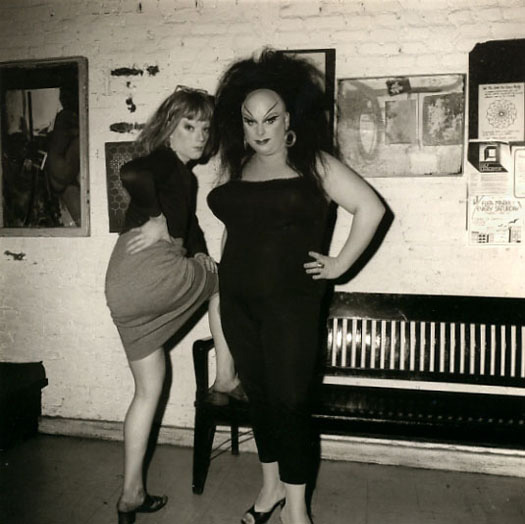
Divine and Jackie Curtis (L) after her Warhol days (Photo: Gary Schoichet)
As with Holly Woodlawn and Candy Darling, Jackie Curtis was not part of the silver Factory. He appeared in films under the Warhol banner after Warhol moved premises to 33 Unions Square West. In addition to appearing in Women in Revolt and Flesh - both directed by Paul Morrissey, but promoted as though they were Warhol films - Jackie wrote and appeared in a number of counter-culture Off-Off Broadway productions. Unlike Candy Darling, Jackie sometimes dressed as a man and sometimes as a woman.
See:
Women in Revolt
Glamour, Glory and Gold
Vain Victory
1947: BOB COLACELLO IS BORN.
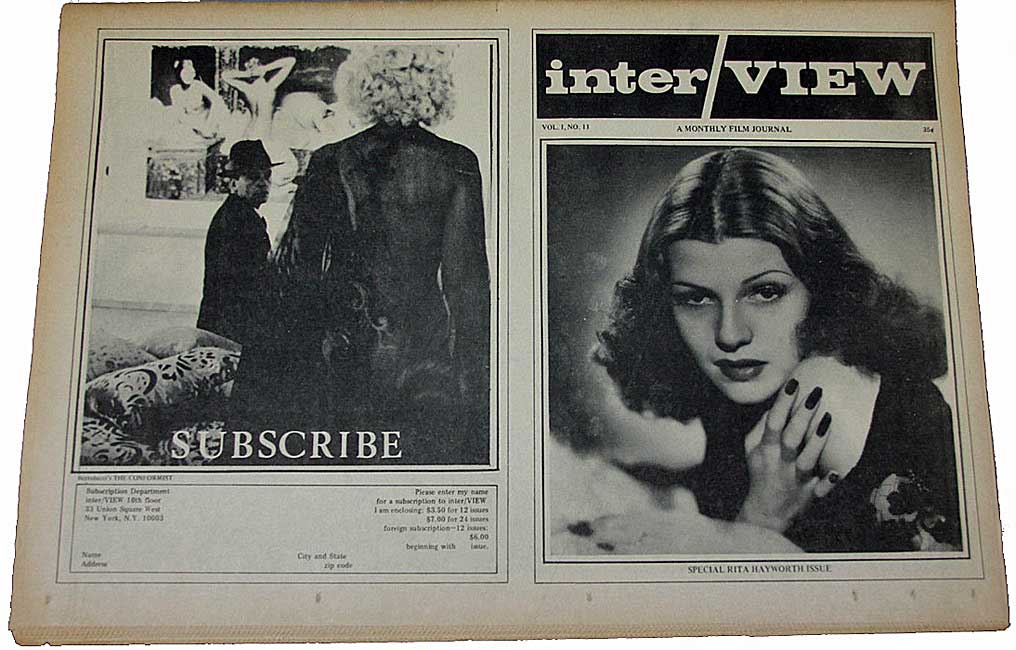
The first issue of Interview magazine that Bob Colacello edited - the Rita Hayworth issue (Vol 1. No. 11) (1970) - see "Jerome Hill and Charles Rydell."
Bob Colacello began as a writer at Interview magazine before becoming its managing editor. He served various roles at the magazine during his employment there. Colacello also wrote for the Village Voice. His articles for the Voice included a review of Trash in the October 9, 1970 issue (See "Trash," p. 1) and an article about Andy Warhol's promotional trip to Germany for Trash - see "Trash," p. 2.
There were four editors on the masthead of the first issue of Interview - Gerard Malanga, Paul Morrissey, John Wilcock and Andy Warhol.
John Wilcock was the "aging hippie publisher" (as described by Bob Colacello) of Other Scenes and provided free typesetting for Interview. (BC7)
By the fourth issue of Interview, Malanga had gone to Europe, leaving Morrissey's name to top the list of editors. Soren Agenoux was hired as managing editor. Soren was a film buff who Paul Morrissey had known through Terry Ork - a contributing editor at Interview who worked at Cinemabilia on Bleeker Street. Many of the early stills in Interview were borrowed from the shop.
Bob Colacello replaced Soren Agenoux as managing editor in the autumn of 1970. His initial salary was $50.00 a week. Colacello had graduated from Georgetown University School of Foreign Service. He lived with his parents in Rockville Center, Long Island and commuted to Manhattan to study for a master's degree in film criticism at Columbia under Andrew Sarris of the Village Voice. (BC4)
Prior to becoming managing editor, Bob Colacello had written film related articles for Interview magazine for $25.00 an article, supplementing his income at Nina Needlepoint where he painted stitching patterns. Even after being made managing editor, Colacello went back to work at Nina Needlepoint in the Fall of 1971 on a part time basis to supplement his meager Interview salary. (BC102)
Glenn O'Brien, a Georgetown classmate of Colacello, also worked at Nina Needlepoint originally. After Colacello became the managing editor of Interview, he hired O'Brien as an assistant. In late 71 Glenn O'Brien replaced Bob Colacello as managing editor so that Colacello could spend time on a book he wanted to write about Warhol's films. Colacello then became a "contributing editor" of the magazine.
When Rosemary Kent from WWD magazine was made editor-in-chief of Interview in August 1973, Glenn O'Brien quit and was hired by Jann Wenner to run the New York office of Rolling Stone magazine.
Rosemary Kent was fired on June 11, 1975 and soon after Bob Colacello was appointed editor and Peter Lester the managing editor. Within a month, after Lester complained that his titled sounded "too businessy," he was made editor and Colacello was given the title of executive editor, earning a total of $15,600 a year. In 1977 his salary was raised to $23,400 a year. (BC238-9) In addition to being responsible for editorial content of the magazine he was also responsible for advertising sales and promotion. He also wrote his regular column "OUT: Excerpts from the Diary of Bob Colacello" for the magazine.
The last issue of Interview that Colacello worked on was the February 1983 issue. He had approached Warhol with the suggestion that he buy a "small part" of Interview and Warhol had refused. (BC464) After leaving Warhol, he wrote a gossip-filled account of his time working for the artist called Holy Terror: Andy Warhol Close Up.
1948
1948: HOLLY WOODLAWN’S MOTHER MOVES TO NEW YORK.
Holly was left in Puerto Rico to be raised by her grandmother. (HW30)
DECEMBER 31, 1948: JOE DALLESANDRO IS BORN.
Beginning his career as a model for 50's gay porn publication, Physique Pictorial, Joe ended up starring in numerous Warhol films, including Trash and Lonesome Cowboys, before launching a career as an actor in European films and eventually being made a Chevalier ("Knight") de l'Ordre des Arts et des Lettres by the French government.
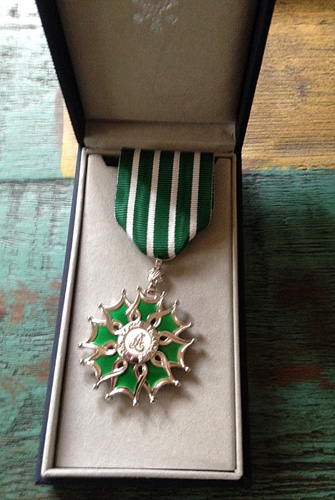
Medal awarded to Joe Dallesandro by the French government, making him a Chevalier ("Knight") de l'Ordre des Arts et des Lettres
Joe Dallesandro was born Joseph Angelo D’Allessandro III in Pensacola Florida, to an 18 year old Italian American sailor, stationed at the local Naval base, and his wife, 16 year old Thelma Testman.
Joe Sr. had married Thelma when she was 14 years old. One year later in New York City they gave birth to Joe’s brother, Robert (Bob) who would later play a small part in Trash and work for Warhol as a chauffeur. Later, Thelma (or Sandy as she was called from an abbreviation of the last two syllables of her married last name), was arrested in Florida for interstate auto theft and sentenced to five years in a Federal penitentiary.
Joe and his brother ended up at Angel Guardian Home in Harlem, awaiting foster care. Both were eventually fostered to the same couple in Brooklyn, with Joe Sr. visiting his sons approximately once a month. When Joe was 14 years old, he went to live with his father in Queens at his grandparent’s house. (JOE13)
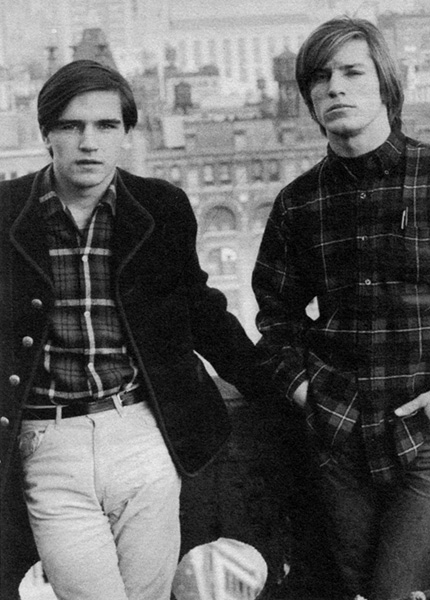
Joe Dallesandro (R) with his brother Bobby
1949
SUMMER 1949: ANDY WARHOL MOVES TO MANHATTAN. (SC14)
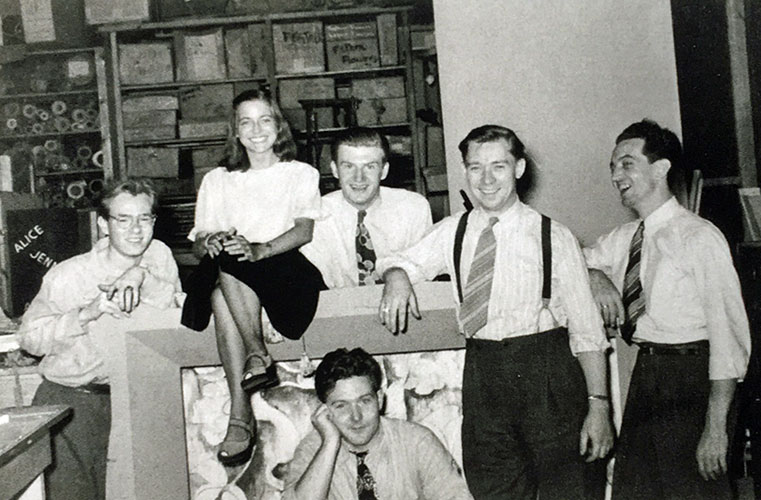
Andy Warhol (L) and fellow students at Carnegie Tech (Photographer unknown)
Warhol graduated from the Carnegie Institute of Technology in Pittsburgh with a Bachelor of Fine Arts in pictorial design and moved to New York a week after graduating in June 1949. PHILIP PEARLSTEIN, a friend from college accompanied Warhol to Manhattan. Pearlstein would later go on to become an important realist painter. They had previously visited Manhattan with another student from Carnegie Tech. (SC14)
While at college Warhol had worked in the display department at the Joseph Horne department store. He had also frequented a local gallery called Outlines where he had been exposed to the work of Joseph Cornell, Marcel Duchamp, John Cage and Buckminster Fuller. He had also taught art classes at the Irene Kaufmann Settlement while still in college. (AWM7)
In Manhattan Warhol and Pearlstein subleased an eighth-floor walkup tenement apartment on St. Mark's Place (and Avenue A) for the summer. According to Pearlstein, "The bathtub was in the kitchen and it was usually full of roaches, incredible roaches."
When they moved a few months later to the large front room of dancer FRANCESCA BOAS's loft on West 21st Street, Andy sent out address change cards in small envelopes filled with glitter announcing, "I've moved from one roach-ridden apartment to another." (BC21)
One of Andy Warhol's first free-lance jobs was at Glamour magazine. He went on to become an extremely successful commercial artist, working for most of the major fashion magazines throughout the fifties, doing album covers for Columbia records, designing Christmas cards, book jackets and retail ad campaigns, including the famous shoe ads for I. Miller in the mid-fifties.
"At the height of his career as a commercial artist, Warhol was earning one hundred thousand dollars a year, a staggering sum for the fifties... on the I. Miller account alone he made fifty thousand dollars one year...Eventually he had to hire assistants to help him keep up with his assignments. He even enlisted the services of his mother, who followed him from Pittsburgh to New York soon after he started making enough money to support them both." (DD25)
During his commercial art days, Warhol was represented by an agent, Fritzie Miller, and his assistants included Vito Giallo and Nathan Gluck. (AWM59) (See "Andy Warhol Pre-Pop: 1949 - 1962".)
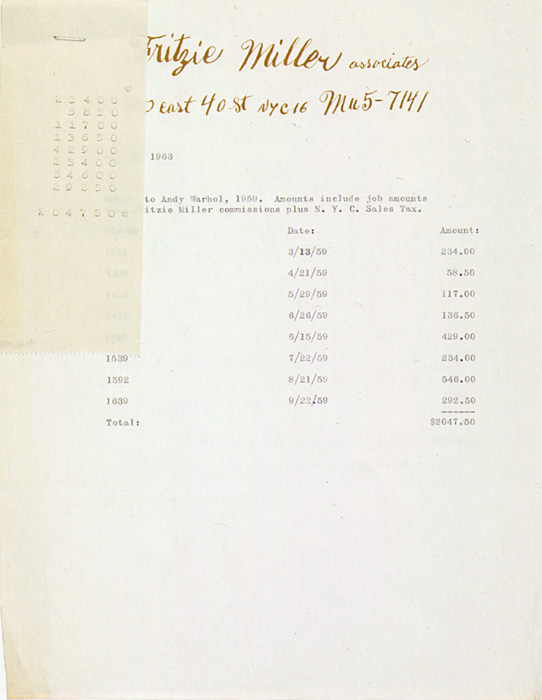
"Itemized list on Fritzie Miller Associates letterhead designed by Andy Warhol (From Fritzie Miller Associates to Andy Warhol, dated May 13, 1963, regarding check payments to Andy Warhol, calendar year 1959)" (TI285) [$2,047.50 in 1959 was the equivalent of $16,946.62 in 2016.]
1950
SUMMER 1950: WARHOL LIVES AT 74 WEST 103RD STREET.
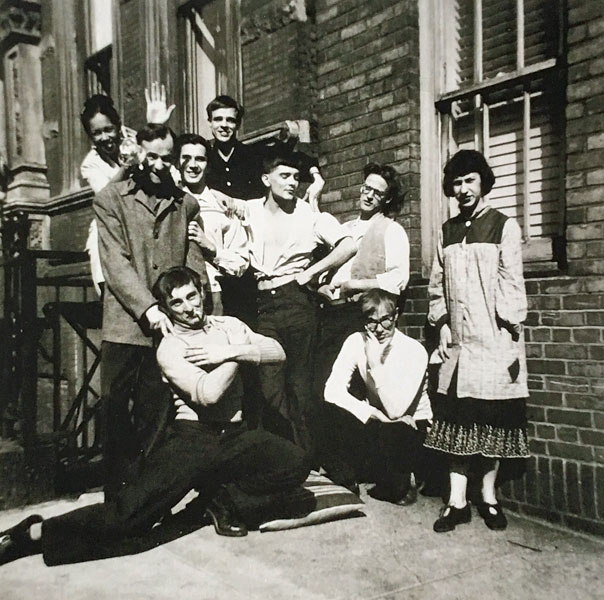
The 103rd Street gang - New York 1950: Top row (L): Mata (a girlfriend of Victor Reilly) and Jack Hudson, Second Row: Joey Ross, Victor (Buddy) Reilly, Tommy Quinlan, Dale Blosser and Ellie Simon, Kneeling front: Jack (Mitch) Beaber and Andy Warhol (Photo: Leila Davies Singeles)
By the summer of 1950 Warhol was living with other classmates from Carnegie Tech at 74 West 103rd Street. He received a phone bill dated July 1, 1950 at that address (to "Andy Warhol") for $95.56 ($955.02 in 2016 terms). He later received a letter, dated July 1, 1951, from an attorney seeking full payment of his telephone bill.
The 103rd Street roommates are referred to in The Philosophy of Andy Warhol (From A to B and Back Again). The Philosophy book, although written in the first person as though Warhol wrote it, was actually ghosted by Pat Hackett, Bob Colacello and Brigid Berlin. (See The Philosophy of Andy Warhol (From A to B and Back Again). In Chapter One of the book, it says "At one point I lived with seventeen different people in a basement apartment on 103rd Street and Manhattan Avenue, and not one person out of the seventeen ever shared a real problem with me. They were all creative kids, too - it was more or less an Art Commune - so I know they must have had lots of problems, but I never heard about any of them. There were fights in the kitchen a lot over who had bought which slice of salami, but that was about it. I worked very long hours in those days, so I guess I wouldn't have had time to listen to any of their problems even if they had told me any, but I still felt left out and hurt."
After leaving 103rd Street, Warhol apparently stayed with another Carnegie Tech alumni, Joseph Groell, at 319 East 24th Street for a short period of time. The Warhol museum has documents dated December 1950 and February 1951 addressed to Warhol at that address.
Joseph Groell:
I had an apartment [that] Philip Pearlstein had after Philip got married… on 24th Street between First and Second Avenue, and sometime in the late fall, I had to go back to Pittsburgh, and Andy moved into my apartment... when I came back, we shared the (East 24th St.) apartment for a month or two until his mother came to New York and he found an apartment, I think in the [East] 70s. Andy was stuck paying the rent [at 103rd St.] and I think he was the primary tenant. And there were all these bizarre people who came and went and ran up a huge phone bill. And finally Andy, I guess, had too much of it, and couldn’t cope with it, and he moved into my place… (See "Andy Warhol: from Nowhere to Up There," p. 13)
By April 1951 it appears that Warhol was living with his ex-classmate, Victor Reilly, on East 75th Street. There is an envelope from Consolidated Edison Company to Andy Warhol at 218 East 75th Street with two account documents, posted April 10, 1951, in Time Capsule 46. The Warhol museum also has an envelope from the New York Telephone Company, dated April 11, 1951, addressed to Andy Warhol c/o Victor Reilly, stamped “First Notice.”
In Time Capsule no. 46 there is also a telephone deposit receipt from the New York Telephone Company to Victor Reilly at 218 East 75th Street, dated March 20, 1951 and a telephone payment receipt from the New York Telephone Company to Victor Reilly at 216 East 75th Street, dated August 6, 1951. The reason for the slight difference in the address (216 vs. 218) is unknown. (MWS) (MW email April 10, 2010)
1951
1951: FIRST PERFORMANCES OF THE LIVING THEATRE IN NEW YORK.
Founded by Julian Beck and Judith Malina, the theatre - based at various locations during the 1950s and 60s - can be seen as a precursor to venues like the Caffe Cino, the Judson Church and La Mama. The top floor of The Living Theatre's 14th Street building, which they performed in from 1959 - 1963, was leased as a studio space to Merce Cunningham and John Cage. (SB21-31)
The group became known for their confrontational theatre where the boundaries between audience and performers became blurred as they often shouted, screamed and groaned through whatever psycho-drama they were performing at the time. Actors performed as themselves performing as actors - not unlike some of Warhol's films in which actors had roles and sometimes scripted lines but , in reality, mostly played themselves. Confrontation in the films was often encouraged or at least applauded after it happened i.e. the scene where Ondine slaps Ronna Page in The Chelsea Girls or where Mary and Brigid abuse Ingrid; the rape scene in Lonesome Cowboys; Ronald Tavel as the interrogator in Screen Test No. 2; Paul Swan being wound up by his offscreen "director" in Paul Swan; Chuck Wein giving Edie a hard time in Beauty No. 2 etc.
Some of the people that Warhol would later use in his films were associated with The Living Theatre. JAMES WARING, who would later appear in Warhol's film, Haircut #1, taught a dance course there and Warhol star TAYLOR MEAD performed at their weekly Living Poetry series. TALLY BROWN (Batman Dracula, Camp, Four Stars) also participated in Living Theatre events.
It was after Warhol saw Jonas Mekas' film of the The Living Theatre's production of The Brig that Warhol began using an auricon movie camera which enabled him to shoot longer scenes with a single-system soundtrack.
(Rufus Collins timeline) (PS232)
See: "Andy Warhol, The Connection and The Brig".
It was also at the The Living Theatre that the woman identified as Warhol's first superstar in Popism, Naomi Levine, was first introduced to Warhol.
Naomi Levine:
"I had met Gerry Malanga and Wynn Chamberlain at a party, and we had spent a couple of days together. Gerry wanted me to meet Andy, so he and Wynn and John Giorno and Andy had me meet them all at The Living Theatre. They were all in tuxedos, and we went to an opening at the Museum of Modern Art." (JW105)
Rufus Collins, one of the few black people to appear in Warhol's films, was also a member of The Living Theatre during the 1960s. The Warhol films that Collins appeared in included two Screen Tests, Kiss, Batman Dracula, Soap Opera and Couch. According to the timeline on Rufus Collin's website, he was not only a member of the Living Theatre, but also appeared in a number of Andy Warhol's films. His timeline makes reference to Andy Warhol's "Screen Test 4" as one of the films and notes that the same year he acted in "Suicide" - although the timeline does not indicated that it was Warhol's film known either as "Screen Test No. 3" or "Suicide." (See "Screen Tests 1,2 and 3.")
Callie Angell:
"The actor Rufus Collins, whose friendship with Warhol began in the 1950s, trained at the Actors Studio in New York and was a member of the Living Theatre in the 1960s... Collins was also one of the earliest stars of Warhol's cinema, beginning in August 1963 with Naomi and Rufus Kiss, the film from which Warhol's Plexiglas sculpture The Large Kiss was derived... Later in his career, Collins played a Transylvanian in the cult feature The Rocky Horror Picture Show (1975), and had a few small roles in more mainstream pictures such as Shock Treatment (1981) and The Hunger (1983). He settled in Europe, dying from AIDS in Holland in 1996." (AD54)
1951: HOLLY WOODLAWN MOVES FROM PUERTO RICO TO THE BRONX.
Holly joined her mother who had moved there earlier and married a Polish Jewish man named Joseph Ajzenberg. Holly's mother and Joseph had met each other during seasonal work at an upstate resort as waitress and waiter. (HW31)
c. EARLY 1950s: ANDY WARHOL AVOIDS THE DRAFT.
There are two selective service cards for Andy Warhol in the collection of the Warhol Museum. The first one, from Warhol's Pittsburgh youth, rated him 1-a which meant he could be drafted without any problem. On the second one, dating from his early days in New York City, his rating had changed to 4-f which meant he was no long eligible to serve. The reason for the change is unknown. (M/B)
SEPTEMBER 1951: ANDY WARHOL DOES HIS FIRST ILLUSTRATION FOR HARPER'S BAZAAR.
Charlie Scheips notes in the foreword to the exhibition catalogue, Andy Warhol: The Bazaar Years 1951 - 1964, that "The first illustration credited to Andy Warhol in Harper's Bazaar appeared in the September 1951 issue of the magazine. Warhol illustrated both handbags and shoes for that 'Junior Bazaar' feature." (HB2)
1952
1952: ANDY WARHOL WINS HIS FIRST AWARD.
He won the award from the Art Directors Club for graphics done for a CBS radio program called The Nation's Nightmare. (AWM60) See Andy Warhol - "The Nation's Nightmare."
JUNE 16 - JULY 3, 1952: ANDY WARHOL HAS HIS FIRST EXHIBITION IN NEW YORK.
The exhibition was at the Hugo Gallery on Fifty-fifth Street. It was called Fifteen Drawings Based on the Writings of Truman Capote. Having been attracted by the jacket photograph of Truman Capote on his book Other Voices, Other Rooms, Andy tried to contact TRUMAN CAPOTE, sending him various letters and then telephoning him at his apartment.
Capote's mother, an alcoholic who lived with Truman, was at first friendly toward Andy though she eventually told him to leave her son alone, calling Warhol a faggot. Although invited to the opening, Truman Capote did not attend. (DD25-26/BC402) (Some accounts indicate that Truman did attend.)
See also: JUNE 1952: THE HUGO GALLERY in the Pre-Pop section.
1952: ANDY WARHOL'S EX-ROOMMATE PHILIP PEARLSTEIN DOES A SUPERMAN PAINTING.
AUTUMN 1952: THE TANAGER GALLERY OPENS.
The Tanager Gallery was a co-operative artists' gallery at 90 East 10th Street - next door to Willem de Kooning's home.
1952 or 1953: ANDY WARHOL IS REJECTED BY THE TANAGER GALLERY.
According to Pop: The Genius of Andy Warhol, Warhol submitted "boy drawings" to the Tanager twice unsuccessfully, although many sources indicate only one attempt.
From Pop: The Genius of Andy Warhol
:
"As Joseph Groell, a Tanager member, recalled, Andy asked him in 1952 or 1953 to submit some Warhol drawings for a guest show. The drawings 'weren't really erotic,' Groell recalled, 'they were head drawings. Because I was a friend' (he and Andy were rooming together), 'I promised him I'd take the drawings down. I was very embarrassed, but I did it. Of course, they wouldn't show them. I told Andy very nicely that people weren't interested. If he was hurt, he didn't show it.'" (SC33)
1954
1954: ANDY WARHOL EXHIBITS AT THE LOFT GALLERY.
See New York: Loft Gallery (3 Exhibitions).
1954: VALERIE SOLANAS GRADUATES FROM HIGH SCHOOL.
She gets an “A” in all subjects except physics, for which she receives a “B”. She enters the University of Maryland at College Park and does well, later spending less than a year at the Graduate School of Psychology at the University of Minnesota. (UV184)
1955
JANUARY 1955: FIRST ISSUE OF FILM CULTURE MAGAZINE IS PUBLISHED.
The founder of the magazine, Jonas Mekas, distributed and screened many of Warhol's early films and promoted them in the pages of The Village Voice newspaper in New York for which he wrote a regular column titled "Movie Journal" from 1958. In December 1964, Andy Warhol received Film Culture's Independent Filmmakers' Award.
Mekas was a Lithuanian poet who had arrived in the U.S. (with his brother Adolfas) on 29 October 1949 after surviving four years in displaced persons camps in Europe. His account of his time in the camps was later published as I Had Nowhere to Go (Newfane, Vermont: Black Thistle Press, 1991) (DJ4)
David E. James (To Free the Cinema: Jonas Mekas & The New York Underground):
"While it was oriented toward Europe, from the beginning Film Culture gave sympathetic critical attention to American film, and eventually seminal work on Hollywood appeared there, most notably Andrew Sarris's 'Notes on the Auteur Theory in 1962' and 'The American Cinema' (appearing in 1963 in nos. 27 and 28 respectively). This tolerance did not extend to the avant-garde; an early issue contained Mekas's immediately notorious attack, 'The Experimental Film in America,' in which he lambasted the 'adolescent character,' a putative 'conspiracy of homosexuality,' the 'lack of creative inspiration,' and the 'technical crudity and thematic narrowness' variously to be found in the work of young filmmakers including Stan Brakhage, Gregory Markopoulos, Curtis Harrington,and Kenneth Anger. Mekas himself later termed this a 'Saint-Augustine-before-the conversion piece,' and the religious metaphor is entirely appropriated, for within a few years he was the fiercest advocate of what he had come to see as a new and distinctively American film culture, and an entirely new sense of its political significance." (DJ7-8)
APRIL 1955: ANDY WARHOL IS HIRED BY I. MILLER & SONS.
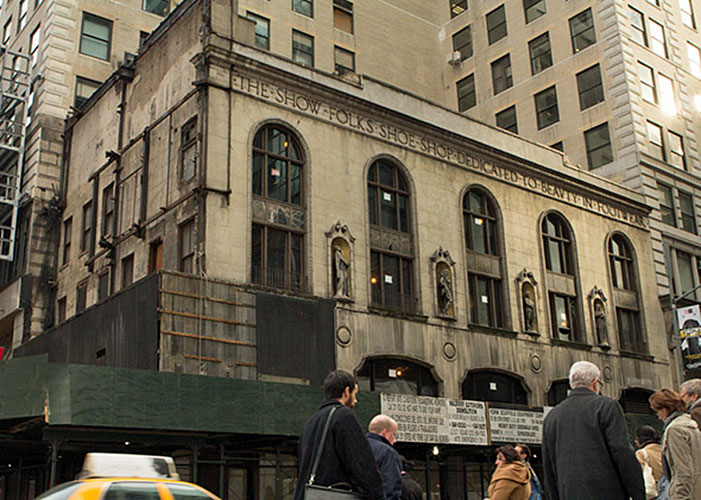
The I. Miller shoe shop - "The Show Folks Shoe Shop Dedicated to Beauty in Footwear" (Photo: © Tristan Fuge)
Warhol received an annual retainer of $12,000 from I. Miller. (SC22) $12,000 in 1955 was the equivalent of $107,844.63 in 2016.
1955: HOLLY WOODLAWN MOVES TO SOUTH BEACH.
Holly, her mother and her stepfather moved from the Bronx to in South Beach in Miami, Florida. (HW36) Holly lived there until running away to New York in 1962.
c. LATE 1955: ANDY WARHOL MEETS CHARLES LISANBY.
Warhol and Lisanby would go on a round-the-world tour together in 1956.
From Pop: The Genius of Andy Warhol
:
"Andy and Lisanby met at a party in late 1955... Andy was smitten; Lisanby was not... What Andy really wanted was for Lisanby to introduce him to Cecil Beaton... 'Finally I took Andy to a party Cecil gave. After I introduced him, he sat in the corner. He made no impression on Cecil, didn't socialize, didn't talk to anyone. He really did not know how to mix. He always looked, and I'm sure felt, so awkward at parties. He didn't know how to join and have fun and meet people. He had no social graces.'" (SC29)
Lisanby had been introduced to Cecil Beaton by Oliver Messel when Beaton was doing the sets and costumes for Little Glass Clock which ran at the John Golden Theatre from 26 -31 March 1956. Lisanby did the lighting design for the production and then a couple of other shows with Beaton including a Samuel Barber opera, Vanessa, at the Met. (AAT7.55)
Lisanby also worked for CBS as a set designer of television programs, including the popular quiz shows, DOTTO (1958) and The $64,000 Question, as well as the Garry Moore Show before being lured to NBC where he worked on the Kraft Music Hall and the Red Skelton Show, among others. He moved to Southern California in the late 60s and would go on to win three Emmy Awards for the Benjamin Franklin mini-series (1974), a Barry Manilow special and his personal favourite, Baryshnikov on Broadway (1980). He was also the set designer for quite a number of television commercials including Merrill Lynch, Panasonic and Irish Spring.
See also CHARLES LISANBY.
1956
c. 1956: ANDY WARHOL IS REJECTED AGAIN BY THE TANAGER GALLERY AND HIS FRIENDSHIP WITH PHILIP PEARLSTEIN ENDS.
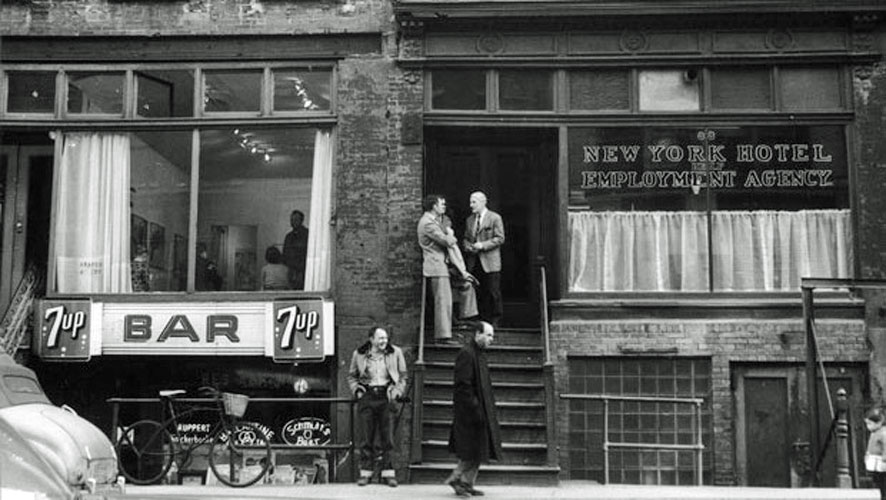
Willem de Kooning (with white hair at top of stairs) standing next door to the Tanager Gallery (above the "Bar" sign). (Photo: © Estate of Fred W. McDarrah)
Andy Warhol had apparently also been rejected by the gallery in 1952 - see 1952 above.
From Pop: The Genius of Andy Warhol
:
"Philip Pearlstein joined the Tanager in 1954; at some point thereafter, probably in 1956, Warhol made his second try [at exhibiting at the gallery]. 'The Tanager was a gallery that got a lot of attention,' Pearlstein said, 'so Andy brought me a portfolio of these 'boy drawings' with their tongues in each other's mouths. The macho painters at the Tanager took one look at these and dismissed them. Andy was very hurt. I remember the talk I had with him after that. I said that sometimes the subject matter gets in the way.' According to Pearlstein, it was the end of their ten-year friendship..." (SC33)
FEBRUARY 14 - MARCH 3, 1956: "DRAWINGS FOR A BOY BOOK BY ANDY WARHOL" EXHIBITION AT THE BODLEY GALLERY.
See 1956: THE BOY BOOK in the Pre-Pop section.
1956: ANDY WARHOL IS INTERVIEWED FOR SHORT PROFILE IN MADEMOISELLE MAGAZINE.
From Pop: The Genius of Andy Warhol
:
"Asked in 1956 to join Alfred Knopf, Pearl Buck, Tennessee Williams, Saul Steinberg, and others as one of that year's sponsors of Mademoiselle's undergraduate 'guest editors,' Andy was interviewed for a short profile. 'Every time I draw a shoe for a job,' he claimed, 'I do an illustration for myself.'" (SC16)
During the same year Mademoiselle also published Truman Capote's story, A Christmas Memory, in their December 1956 issue. They had previously published Capote's story Miriam during 1946.
Warhol has also been credited as the artist for Mademoiselle's calendar of 1956.
APRIL 25 - AUGUST 5, 1956: THE FIRST TIME THAT A WORK BY ANDY WARHOL IS SHOWN IN A PUBLIC MUSEUM.
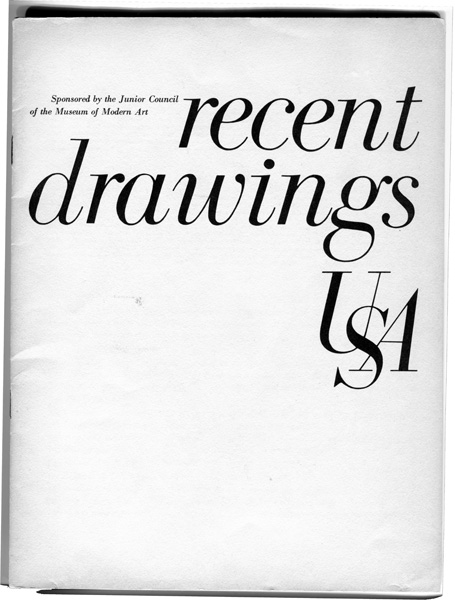
Front cover of the exhibition catalogue of "Recent Drawings USA"
"Recent Drawings USA" was a group show at the Museum of Modern Art that, in addition to a drawing by Warhol, also included work by Josef Albers, Dorothy Cantor, Jane Freilicher, Ellsworth Kelly and Russell Twiggs, amongst others.
Dorothy Cantor was a student at Carnegie Tech when Warhol and Philip Pearlstein were there. Cantor later married Pearlstein. Russell Twiggs also had a connection to the college:
From the "Teachers" section of "The Andy Warhol Family Album" website:
It should be noted that Russell Twiggs also worked for the art department. Though he was not a teacher, he was an important person to the department. He organized student art that was to be critiqued each semester by the faculty. The critiques happened on an official day known as ‘Judgement Day.’ Every student’s art would be lined up and stamped on the back with a Carnegie Institute of Technology stamp noting the day of critique. The faculty would discuss each student’s progress. Russell Twiggs was a fine painter in his own right and he was inspirational to many students including Andy.
His wife, Loreen was the secretary to the head of the department. She befriended Andy during his freshman year and this friendship would play a very important role in Andy’s future. At the end of his freshman year the faculty decided that Andy Warhola was not up to the standard of the department and that he should be flunked. Mrs. Loreen Twiggs was the only person who went before the faculty to tell them that they were terribly mistaken and that they should allow him to at least come back for the summer. She said, “He is being overwhelmed by these veterans…he needs the time and space to show how talented he is!” They agreed to give him another chance.
Russell Twiggs also recognized Andy’s early talents. He saved many of his early student works and later donated them to the Carnegie Museum. (accessed here, December 2016)
Although a reproduction of Warhol's drawing was not included in the catalogue for the MoMA show, his work, "Shoe" is listed among the works exhibited:
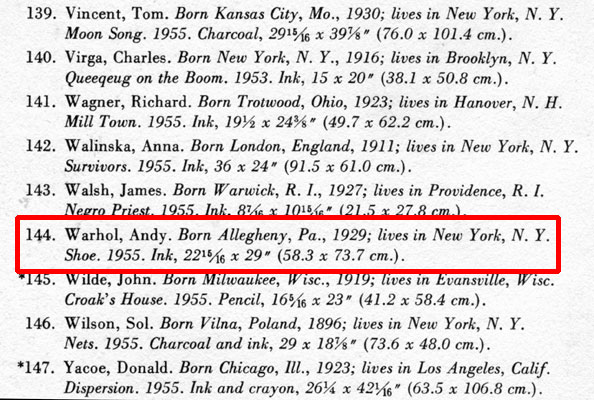
Andy Warhol's listing in the "Recent Drawings USA" exhibition at the Museum of Modern Art. Interestingly, his birth year is given as 1929.
See 1956: RECENT DRAWINGS: U.S.A. in the Pre-Pop section.
JUNE 16 - AUGUST 12, 1956: ANDY WARHOL TOURS THE WORLD.
Warhol's traveling companion was Charles Lisanby on his round-the-world tour.
Also in 1956: One of Warhol's drawings was included in the Recent Drawings U.S.A. exhibit at the Museum of Modern Art. He also received the 35th Annual Art Directors Club Award for Distinctive Merit for his I. Miller shoe advertisements.
OCTOBER 18, 1956: ANDY WARHOL IS REJECTED AGAIN.
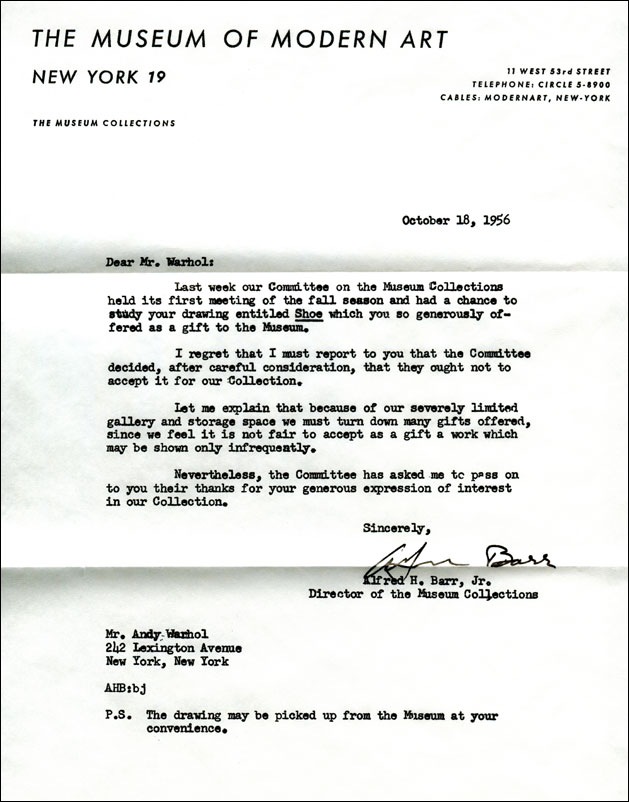
Andy Warhol's rejection letter from the Museum of Modern Art
This time it wasn't the Tanager Gallery, it was the Museum of Modern Art. He tried to donate a "drawing entitled Shoe" to the museum but they rejected it. Presumably it was the same Shoe that he had entered into the "Recent Drawings USA" exhibition at the museum (see above).
DECEMBER 3 - 22, 1956: "ANDY WARHOL: THE GOLDEN SLIPPER SHOW OR SHOES SHOE IN AMERICA" AT THE BODLEY GALLERY.
See SHOES SHOE IN AMERICA (1956) in the Pre-Pop section.
1957
c. 1957: TED CAREY MEETS ANDY WARHOL
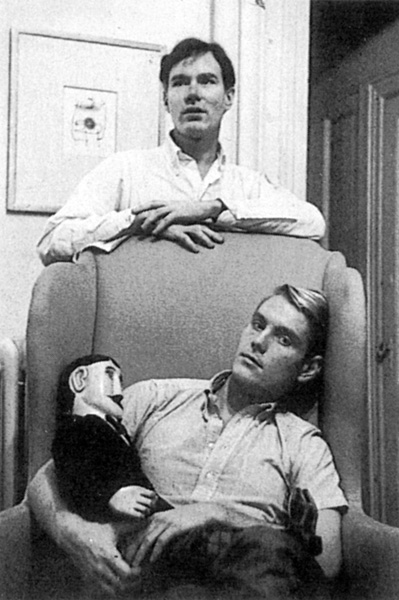
Andy Warhol and Ted Carey (Photographer unknown)
Carey had arrived in New York from Philadelphia in 1954.
Ted Carey:
"I think, I met Andy in the late '50s. It was around 1957. I think it was around 1957... as I remember, I met Andy at an exhibition of drawings he had done. And the exhibition was at Serendipity... And this particular exhibition was an exhibition of drawings of cats. And I think that the title of the show was 'Cats with Hats'... And that was the first time I had met him, and then I saw him shortly after that in the zoo... in the cafeteria of the zoo. And he had remembered meeting me. And he said he would like me to pose for him. So, at that meeting we made a date, and he came by and did one or two drawings of me... At that time, I think I was working for N.B.C. And shortly after that I lost my job at N.B.C. I was unemployed." (PS247)
After Carey met his lover, John Mann, at a party, Warhol also sketched Mann. Mann had moved to New York to work in advertising after graduating from Cambridge. After Mann met Carey at the party, they went home together and the next morning Carey suggested they visit Warhol. Warhol ended up sketching Mann's cock after Carey told him how big it was.
John Mann:
"I remember thinking, 'this is sort of weird. But Ted said, 'Oh, it would be fun!' And Andy said, 'Please let me do it!' I thought, 'Oh well,' and before I knew it - we were all very young and silly - I was sitting with my pants down, with a daffodil wound around my dick. That was my first meeting with Andy." (SC30)
Carey also recalled that "one weekend we [he and Andy] were in Philadelphia at a friend's, and Cecil Beaton was there, and Andy did Cecil Beaton with a rose between his toes... The other things that he [Warhol] started to do [was] a whole group of cock drawings. Beautiful cock-penis drawings." (PS260) Cecil Beaton apparently also sketched Mann and Carey in Carey's apartment.
From Pop: The Genius of Andy Warhol
:
"'It was such a laid-back, languid, campy environment we were all existing in,' said Mann. Nobody would have been surprised to find Noel Coward sipping a cocktail in the Careys' ratty East 88th Street kitchen (Ted shared the apartment with his younger brother Gary, a Columbia graduate student.) Indeed, something like this actually occurred. Getting back from school one night, Gary opened the door onto a remarkable tableau: Cecil Beaton absorbedly sketching Ted and John Mann in flagrante delicto (they were only miming, Mann insisted), while Andy, who was there too, kept trying to peer over the seated Beaton's shoulder. When the session was over, Andy asked for the drawings. Refusing, Beaton thanked his models and left." (SC31)
In 1960, the artist Fairfield Porter painted a picture of Carey and Andy Warhol.
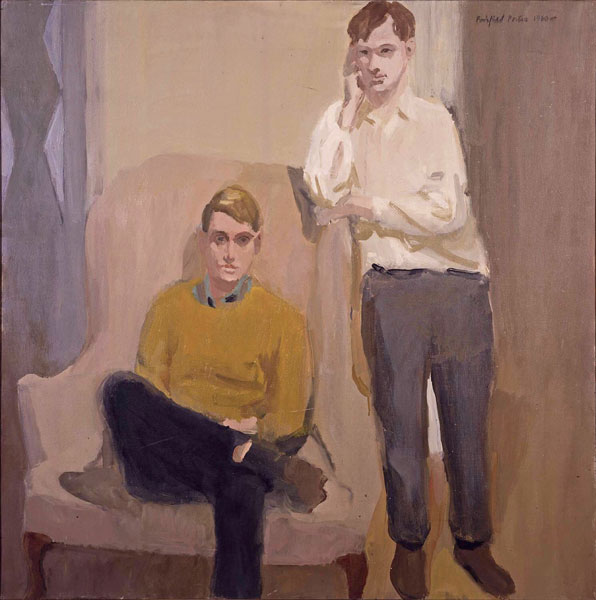
Ted Carey and Andy Warhol by Fairfield Porter
Andy Warhol [via Pat Hackett in POPism: The Warhol Sixties
]:
"I used to go around to all the galleries in the late fifties, usually with a good friend of mine named Ted Carey. Ted and I both had wanted to have our portraits done by Fairfield Porter, and we'd thought that it would be cheaper if he painted us in tandem and then we could cut it apart and each take half. But when he'd posed us, he sat us so close together on the couch that we couldn't slice a straight line between us and I'd had to buy Ted out. Anyway, Ted and I followed the art scene together, keeping up with what was going on." (POP6)
DECEMBER 2 - 24, 1957: A SHOW OF GOLDEN PICTURES BY ANDY WARHOL AT THE BODLEY GALLERY.
An illustration of a golden Christmas tree by Warhol used to publicize the show was also featured in the December issue of Harper's Bazaar. (HB4)
See also: A GOLD BOOK (1957) in the Pre-Pop section.
1958
c. LATE 1950s: ANDY WARHOL MEETS EDWARD WALLOWITCH

Edward Wallowitch (Photographer unknown)
According to Ted Carey, "Edward Wallowitch... was a photographer... who was a very close friend of Andy during the early '50s.... (PS258) According to the cat. rais., "Edward Wallowitch was a professional photographer who met Warhol through Nathan Gluck, probably in the late 1950s." (GF470)
1958: ANDY WARHOL'S MOTHER WINS A GRAPHIC DESIGN AWARD.
Warhol's mother often did the lettering for his designs. Her lettering on the cover of a Louis Hardin album, The Story of Moondog, won an award from the American Institute of Graphic Arts as "Andy Warhol's mother". The writing had been rearranged graphically by Warhol for the cover. (AWM58)
1958: THE JUDSON GALLERY OPENS.
From Playing Underground: A Critical History of the 1960s Off-Off-Broadway Movement
by Stephen J. Bottoms:
"Founded in 1892 by Baptist minister Edward Judson, its [the Judson Memorial Church's] initial mission was to be a church that would 'cross the tracks,' by serving both the wealthier families to the north of the Square and the Italian immigrant ghetto to the south... This was a heritage taken very seriously by Dr. Howard Moody, who in 1956 began a pastorate that was to last almost four decades... The Judson Gallery was established in 1958, in the church's basement Ping-Pong room, and in 1959-60, its program was curated by Allan Kaprow - fresh from his success with 18 Happenings in 6 Parts at the Reuben Gallery. Consequently, Judson became an early center for happenings such as Kaprow's The Shrine and Claes Oldenburg's Ray Gun Specs events - which incorporated work by Jim Dine, Al Hansen [father of Warhol star BIBBE HANSEN], Dick Higgins, and Robert Whitman. Over the next few years, the church was also to initiate dance and poetry programs." (SB66)
In 1961, The Judson Poets Theatre was established at the church. The Judson Dance Theater would also be located there the following year - their first concert was on 6 July 1962. (JDxi)
(See the Visual Arts, Dance, Theater and Music sections of the "Arts" section here.)
DECEMBER 1958: THE CAFFE CINO OPENS IN NEW YORK.
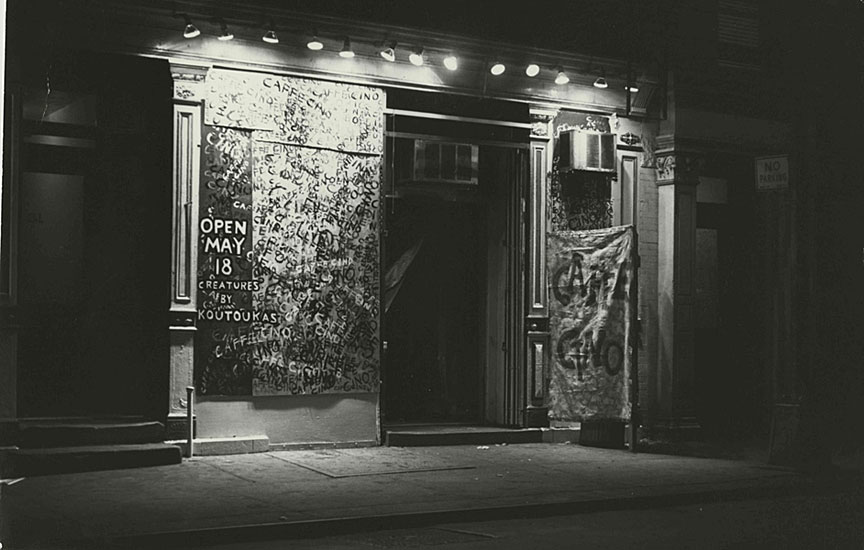
Caffe Cino (Photographer unknown)
According to Cino playwright, Robert Patrick, Warhol stars who did work at the Cino included Ondine, Taylor Mead, Ronald Tavel, Louis Waldon and Mary Woronov. Andy Warhol filmed the Cino productions of Robert Heide's play The Bed and Soren Agenoux's play Charles Dickens' Christmas Carol.
(See "Caffe Cino.")
1959
1959: BILLY NAME MEETS ANDY WARHOL.
Billy met Andy while working as a waiter at Serendipity 3, an espresso boutique in the chic upper east side of Manhattan. After a brief sexual relationship, Billy and Andy became friends. Billy would later create the silver look of the Factory. (B)
SPRING 1959: LOU REED HAS SHOCK TREATMENT.
Lou's parents sent him (at the age of seventeen) to a psychiatrist to be cured of "homosexual feelings and alarming mood swings." Reed was referred to Creedmore State Psychiatric Hospital for electroshock treatment three times a week for eight weeks. After finishing the course of treatment he was put on strong tranquillizers. (LR15-6)
MAY 1959: ANDY WARHOL ILLUSTRATES SPA SHOES IN HARPER'S BAZAAR.
Charlie Scheips [Foreword to Andy Warhol: The Bazaar Years 1951-1964]
"In addition to his shoe, accessories and beauty illustrations, Warhol also created from the very beginning literally hundreds of what I would call 'incidental' drawings for Harper's Bazaar. Warhol's graphic menagerie of fanciful cupids, whimsical butterflies, cherubic angels, sultry mermaids and slinky cats also appeared in dozens of the magazine's pages as the decade grew on. Always quick to recycle past work, Warhol's illustration for 'spa shoes' in the May 1959 issue of Bazaar is topped by one of his smiling cats, reminiscent of his 1954 book 25 Cats name Sam and one Blue Pussy."
See also: 25 CATS NAME SAM AND ONE BLUE PUSSY (c.1955) in the Pre-Pop section.
JUNE 2, 1959: THE CONNECTION OPENS AT THE LIVING THEATRE.
Jack Gelber's play about heroin addicts, The Connection was the inaugural production of the Living Theatre's venue on14th Street and 6th Avenue. (SB28) The boundaries between "theatre" and real life became blurred as actors as the "playwright" and "producer" addressed the audience directly, telling them that they had assembled a cast of real heroin addicts who would be improvising around a loose scenario.
See Andy Warhol, The Connection and The Brig.
AUTUMN 1959: LOU REED GOES TO COLLEGE.
Lou Reed attended the Bronx campus of New York University while also going to the Payne Whitney psychiatric clinic for an intensive course of post-shock treatments. (LR28)
In the Spring of 1960, after completing his Payne Whitney sessions (although still on tranquillizers), he transferred to Syracuse University where he first formed a folk band, and then in his sophomore year, a rock and roll band called LA and the Eldorados. (LR50)
At Syracuse, he also met guitarist Sterling Morrison. Although Sterling was not a student he hung out on campus, visiting his student friend Jim Tucker and sitting in on some classes. (LR28/33-4)
Sterling Morrison:
"He [Lou] tried the gay scene at Syracuse, which was really repellent. He had a little fling with some really flabby, effete fairy. I said 'Oh, man, Lou, if you want to do it, I hate to say it but let's find somebody attractive at least.'" (LR48)
OCTOBER 1959: ANDY WARHOL ATTENDS THE OPENING OF THE GUGGENHEIM MUSEUM.
The artist, Ellsworth Kelly, saw Warhol at the opening.
Ellsworth Kelly:
"Andy was dressed in a little dark suit and a white shirt and tie, very cute. Afterwards, some people - it may have been Robert Fraser, later a well-known English dealer and scene-maker - were talking about going to a leather bar, and Andy said, 'Oh, can I go, too? I want to go!'" (SC69)
DECEMBER 1 - 24, 1959: "ANDY WARHOL: WILD RASPBERRIES" AT THE BODLEY GALLERY.
Exhibited works were also featured in the December 1959 issue of Harper's Bazaar.
From Andy Warhol: The Bazaar Years 1951-1964:
"Warhol again returned to the pages of the magazine [Harper's Bazaar] for its December 1959 issue with illustrations for 'Noel Provincial' written by his friend Susie Frankfurt, with hand lettering by Warhol's mother. That month the Bodley Gallery exhibited these same drawings with different inedible recipes, calling the show 'Wild Raspberries,' a tongue-in-cheek allusion to Ingmar Bergman's film Wild Strawberries." (HB4)
See also: WILD RASPBERRIES (1959) in the Pre-Pop section.
